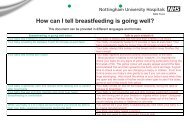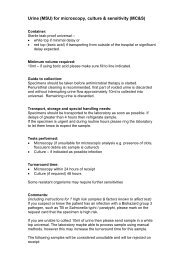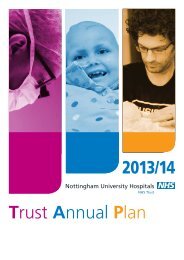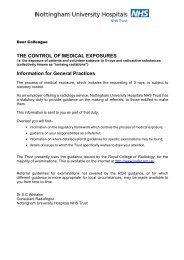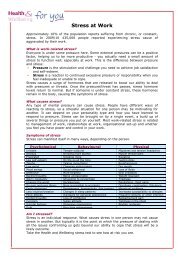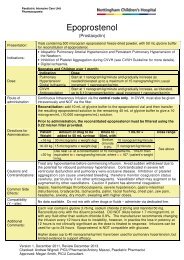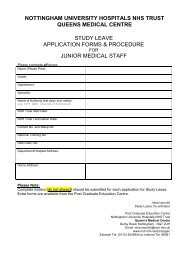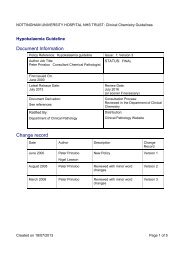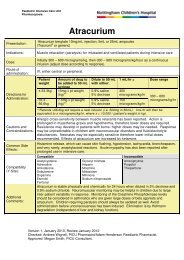Hypernatraemia - Nottingham University Hospitals NHS Trust
Hypernatraemia - Nottingham University Hospitals NHS Trust
Hypernatraemia - Nottingham University Hospitals NHS Trust
You also want an ePaper? Increase the reach of your titles
YUMPU automatically turns print PDFs into web optimized ePapers that Google loves.
NOTTINGHAM UNIVERSITY HOSPITALS <strong>NHS</strong> TRUST: Clinical Chemistry Guidelines<strong>Hypernatraemia</strong> GuidelineDocument InformationPolicy Reference: <strong>Hypernatraemia</strong> Guideline Issue: 1: Version 3Author Job Title:Peter Prinsloo Consultant Chemical PathologistSTATUS: FINALFirst Issued On:June 2000Latest Reissue Date:July 2013Document Derivation:See referencesRatified By:Department of Clinical PathologyReview Date:July 2016(or sooner if necessary)Consultation Process:Reviewed in the Department of ClinicalChemistryDistribution:Clinical Pathology WebsiteChange recordDate Author Description ChangeRecordJune 2000Peter PrinslooNigel LawsonNew Policy Version 1August 2005 Peter Prinsloo Reviewed with minor wordchangesMarch 2008 Peter Prinsloo Reviewed with minor wordchangesVersion 2Version 3Created on 18/07/2013 Page 1 of 4
NOTTINGHAM UNIVERSITY HOSPITALS <strong>NHS</strong> TRUST: Clinical Chemistry Guidelines<strong>Hypernatraemia</strong> GuidelineDefinitionSodium concentration greater than 145mmol/L. Usually hypernatraemia only becomesclinically significant if sodium concentration is greater than 154mmol/L or there is a rapid rise insodium concentration (> 20mmol/L in 24 h)Symptoms/SignsAltered mental statusLethargyFeverNauseaVomitingSeizuresComaCommon CausesInadequate fluid intake, dehydrationNon-ketotic hyperglycaemia (HONK)More Rare CausesDiabetes InsipidusConn’s syndromeLithium therapyCreated on 18/07/2013 Page 2 of 4
NOTTINGHAM UNIVERSITY HOSPITALS <strong>NHS</strong> TRUST: Clinical Chemistry GuidelinesAcute sodium poisoning through oral / IV intakeHypodipsic hypernatraemia (thirst centre affected)SpuriousSampling errorContamination with sodium saltsEvaporation of samplePlease note this list is not comprehensive and other causes may need to be considered.Clinical AssessmentAssess fluid status and fluid balance chartsDehydration – FindingsOliguria ( 1000mmol/kg - In elderly patients urinaryconcentrating capacity may fall to less than 700mmol/kg)Diabetes insipidusIn diabetes insipidus the urine is not concentrated and there will be large volumes(often greater than 3L/24hour)Initial InvestigationsPlasma- Sodium- Potassium- Urea- Creatinine- GlucoseCreated on 18/07/2013 Page 3 of 4
NOTTINGHAM UNIVERSITY HOSPITALS <strong>NHS</strong> TRUST: Clinical Chemistry Guidelines- OsmolalityUrine (random, no preservative)- Sodium- Potassium- Urea- Creatinine- Osmolality- Dipstick: glucose, ketonesMeasure 24-hour urine excretion if diabetes insipidus is suspected.Further Investigations? Diabetes Insipidus? Conn’s SyndromeIf all common causes of hypernatraemia have been excluded and you suspect DiabetesInsipidus, please contact either a Consultant Endocrinologist or the Duty Biochemist for furtheradvice on investigation and possible water deprivation testing.References1) Sodium. Kumar S, Berl T. The Lancet 1998; 352: 220-229.2) <strong>Hypernatraemia</strong>. Adrogue HJ, Maclias NE. New England Journal of Medicine 2000;342:1493-1499.Disclaimer:These guidelines have been registered with the <strong>Trust</strong>. However,clinical guidelines are guidelines only. The interpretation and applicationof the clinical guidelines will remain the responsibility of the individualclinician. If in doubt contact a senior colleague or expert. Caution isadvised when using guidelines after the review date.Created on 18/07/2013 Page 4 of 4



